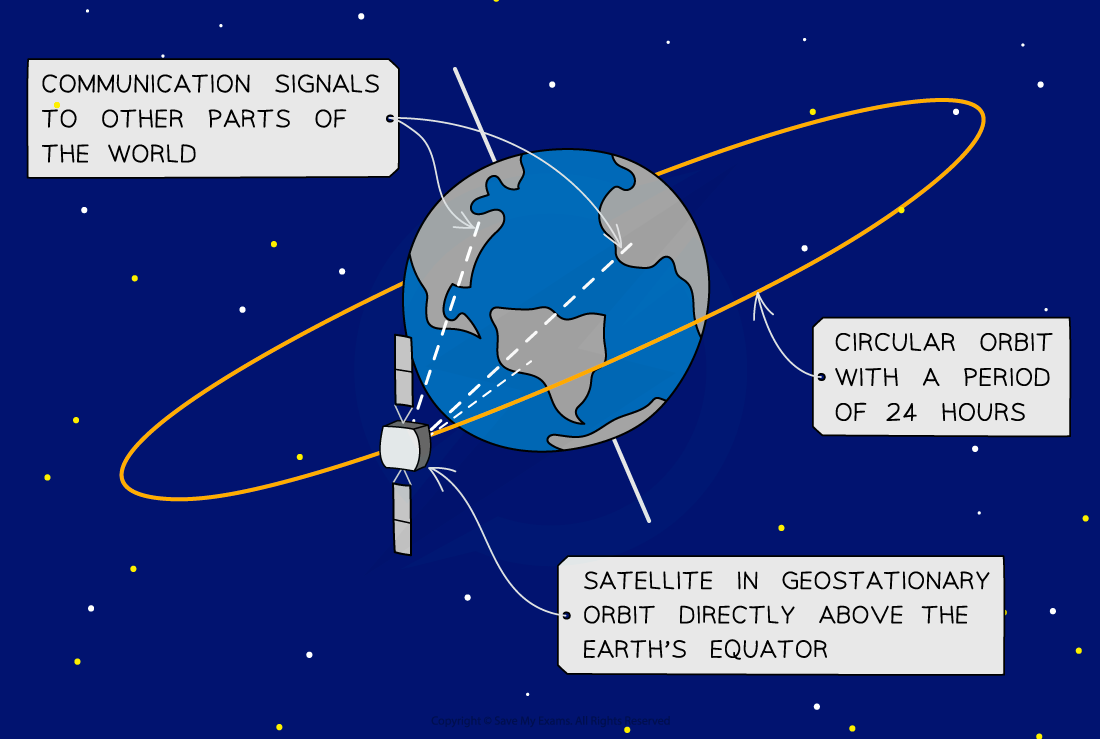Communications (Cambridge (CIE) IGCSE Physics): Revision Note
Exam code: 0625 & 0972
Communications with satellites
Communications with artificial satellites use microwaves:
Some satellite phones use low-orbit artificial satellites
Some satellite phones and direct broadcast satellite televisions use geostationary satellites
Geostationary and polar-orbiting satellites

Geostationary and polar orbits around the Earth
Low orbit satellites
Low orbit satellites orbit much lower than geostationary satellites, at around 200 km above sea level
Used for monitoring the weather, military applications, and taking images of the Earth’s surface
There is a much shorter time delay for signals compared to geostationary orbit signals
The signals and images are much clearer due to the lower orbit
However, there is limited use in any one orbit because more than one satellite is required for continuous operation
Polar orbit satellites are a type of low Earth orbit satellite that orbit around the poles
Low orbit satellites

Some satellite phones use low-orbit artificial satellites if a more detailed signal is required
Geostationary satellites
Geostationary satellites orbit above the Earth’s equator
The orbit of the satellite is 24 hours
At a height of 36 000 km above the Earth’s surface, much higher than polar satellites
Used for radio and telecommunication broadcasting around the world due to its high orbit
Orbit of geostationary satellite

Some satellite phones and direct broadcast satellite television use geostationary satellites
Systems of communications
Extended tier only
Many important systems of communication rely on long-wave electromagnetic radiation, including:
Mobile phones, wireless internet & satellite television (using microwaves)
Bluetooth, terrestrial television signals & local radio stations (using radio waves)
Optical fibres (using visible or infrared waves)
Microwaves
Microwaves can be used to transmit signals over large distances
As with radio waves, microwave signals will be clearer if there are no obstacles in the way which may cause diffraction of the beam
On the ground, mobile phone signals use a network of microwave transmitter masts to relay the signals from the nearest mast to the receiving phone
They cannot be spaced so far apart that, for example, hills or the curvature of the Earth diffract the beam
Mobile phones and wireless internet use microwaves because microwaves are not refracted, reflected or absorbed by the atmosphere or ionosphere
This means satellites can relay signals around the Earth allowing communication 24 hours a day all around the world
Also, they can penetrate most walls and only require a short aerial for transmission and reception
Radio waves
Radio waves can be used to transmit signals over short distances
Radio waves have wavelengths of around a kilometre
Radio waves can diffract around the hills
This is because radio waves have wavelengths similar to the size of the hill
Bluetooth uses radio waves instead of wires or cables to transmit information between electronic devices, over short distances, such as phones and speakers
Bluetooth signals tend to have shorter wavelengths than radio or television signals
This enables high rates of data transmission that can only be used over a short distance (for example, within a household)
This means they can pass through walls but the signal is significantly weakened on doing so
Radio waves diffract around hills

Radio signals diffract around hills because they are a similar wavelength to the hill
Optical fibres
Optical fibres use visible light and short-wavelength infrared radiation for cable television and high-speed broadband
Visible light and infrared radiation can carry high rates of data due to their high frequency

Unlock more, it's free!
Did this page help you?